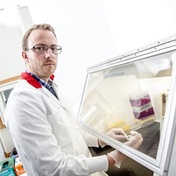The organic substance, developed by Canadian researchers, attracts and supports cells necessary for tissue repair and can be directly injected into problem areas.
"The collagen-based material we use is injectable," Explains Dr Erik J. Suuronen of the University of Ottawa Heart Institute. "It is liquid upon injection, and then gels upon exposure to body temperature," he says.
This gelling that occurs within the body, say in the heart for example, produces the scaffold that cells can interact with to repair damaged muscle.
"Progenitor cells are attracted to the scaffold from the bloodstream, and the scaffold then improves cell survival and in turn, the progenitor cells send out homing signals that call other cells to join them in growing new blood vessels," explains Suuronen. (Progenitor cells are capable of growing into a variety of different cell types.)
The study, published online in The FASEB Journal is a major step toward treatments that allow people to more fully recover from injury and disease, rather than having to live with chronic health problems, the researchers said in a statement. "It may even help reduce the need for organ transplantation by allowing physicians to save organs that would previously have been damaged beyond repair," they wrote.
"Ultimately, we envision a scaffold material that can be taken off the shelf and injected into the hearts of patients suffering from blocked arteries," said Suuronen. "The scaffold materials would direct the repair process, and restore blood flow and function to the heart."
Not like trachea transplantThe study follows reports late last year of a trachea transplant in which a donor trachea was stripped of its cells (to leave only a scaffold), and then seeded with stem cells from the recipient.
The stem cells helped transform the scaffold into a functioning trachea which was then successfully implanted into the recipient.
"Our work differs from the recent report on trachea transplant because with our approach, no cell transplantation is required. The material guides the cells already in the body to perform the regenerative process," explains Suuronen.
"Also, our material does not require extensive procedures needed to prepare the donor tissue. It is simply a matter of injecting the material into the desired site of injury/damage," he said.
How the study was conductedThe researchers tested the material in three groups of rats, with each group suffering from a lack of blood oxygen (ischaemia) to their thigh muscles.
The muscles in the first group of rats were treated with the smart scaffold, the second group of rats received a scaffold not engineered for cell attachment, and the third group received a placebo.
Two weeks after treatment, rats treated with the "smart" scaffold had more new blood vessels and better functional recovery while rats from the other two groups only had minimal improvement.
"This is a major development toward radically new treatments for heart and muscle disease," said Dr Gerald Weissmann,, Editor-in-Chief of The FASEB Journal. "If this research holds up in humans, it has the potential to save more lives than any other major advance in the field since the stent."
(EurekAlert/Health24, January 2009)
Read more:The amazing stem cell trachea transplant
Dead hearts beat again




 Publications
Publications
 Partners
Partners














